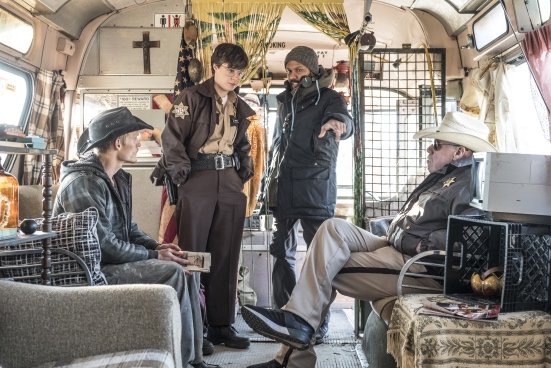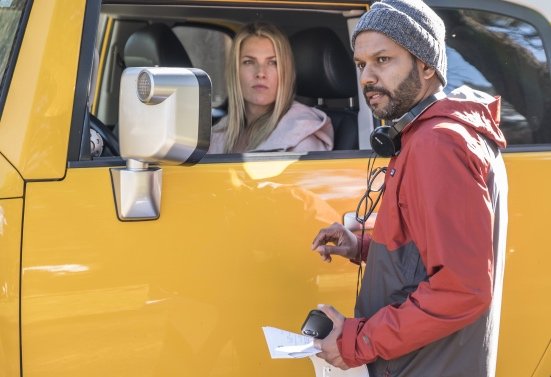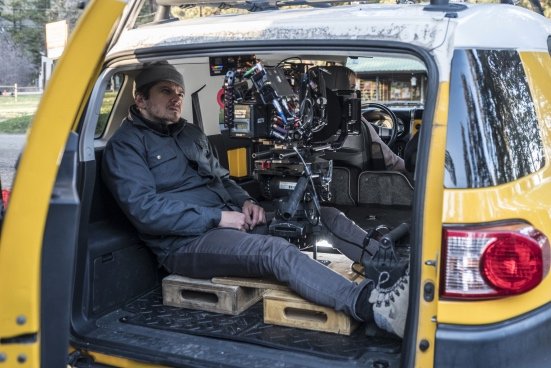
Sailesh Ghelani gets on a zoom call with Hollywood Producer-turned-Director Naveen Chathapuram who fills him in on his film The Last Victim starring Ron Perlman. He also gives us some insights about actor Chris Hemsworth and director M Night Shyamalan and why being an outsider is sometimes very helpful in filmmaking.
1. Is work getting back to normal after all the lockdowns?
Yeah absolutely. About 50-60% of the people are out and about here in Chicago. Our offices are still at about 30% occupancy though. My mother and grandparents have all been vaccinated. Confidence is returning and people are starting to go out more.
2. Were you born and raised in the US?
I was born in Coimbatore in Tamil Nadu and grew up in Calicut in Kerala. We moved to Chicago (USA) when I was 12 years old and have been here since. My mom’s side of the family are all here. I have extended family in India.

Director Naveen A Chathapuram and Director of Photography Lukasz Pruchnik (Go Goa Gone). Behind The Scenes – The Last Victim. Kuiper’s Peak, British Columbia
3. What makes a producer want to turn director? Is there a benefit to being both?
I think the question should be ‘What makes an aspiring director become a producer?’. I went to film school for directing as storytelling excited me. However, when I made my first film as a First Assistant Director, I ended up doing fund raising and managing production. At the end of it I got a credit as one of the producers of the film. What I learned from that experience was that as a director you need to have answers for everything. I wanted to go on a journey to learn the nuts and bolts of production and also the financial aspects of filmmaking so that when I did become a director I’d have the business acumen to back the creative vision.
I was fortunate to work with a lot of great directors and learn from the sidelines. One of my mentors was the late Stephen Milburn Anderson, a protégé of Oliver Stone; he made the film South Central (1992) that became a cult phenomenon. I’ve also worked with first-time directors who have great vision but when it comes to execution they have blind spots sometimes.
One of the things you learn as a producer is that when it comes to finance, distribution or even a film’s poor performance, the producer is the one left holding the bag. Now that I’ve stepped into the director’s shoes I realise the responsibility falls on the director and producer.

Naveen Chathapuram with visionary Writer/Director, the late Stephen Milburn Anderson (South Central, Hearts of Stone, CASH) on the sets of CASH (2010)
4. What interested you about the story in The Last Victim and how did you approach this film differently?
The original script for The Last Victim was written in 2002 or 2003. I was introduced to Doc Justin (Dr. Neal Justin), anthropologist in Arizona. He invited me to go to Tucson to write the script and get the film produced. As soon as I heard the plot I thought it was exciting; it was an homage to the thrillers from the 70s and 80s. We wrote the script in about two to three months and we were going to shoot it there in summer but our location, a mountain, caught fire and we had to push the shoot. But then I got busy with my own career in production. And then at some point I realised the true reason I entered this business: to tell stories. Intuitively, The Last Victim came to mind. I picked up the script and read it, but I knew it was dated. So, I shortlisted some writers and I picked Ashley James Louis, a hugely talented writer. He read it in a day and said it had some great elements and when I was in Los Angeles next he showed his notes and then Ashley and I went through 14 different drafts of the script but it wasn’t that different from the original.
5. Was it scary getting into your first film as a director?
It is very scary. There’s an excitement that comes from the fear. Balancing the danger with preparation is the key. Independent Hollywood films are tough to get made. It was a big responsibility and bringing that energy every day was challenging. We were shooting in minus fifteen-degree temperatures on those cliffs. You have to make decisions in those conditions but it was exciting too. Then the pandemic hit and everyone was in lockdown and now you have to create a new post-production work flow with teams scattered across the world. I had to edit and do the sound design of the movie remotely on cutting-edge software.

Behind The Scenes – The Last Victim. Kuiper’s Peak, British Columbia
6. You said in an interview about 10 years ago that for the film Cash (2010), which you produced, it involved a lot of ‘personalised pitching’ to investors. What does that mean and how are things different today in the way you pitch?
At that time I would receive general decks from other filmmakers comparing movies that made a lot of money with lower budget films. I tried to do something different; I went to the core of the story and did research on demographics and tailored my proposal to the type of investor I was pitching to. So, the presentations had to be customised to the audience. Today, my presentations are more professional.
7. Do you mean you take less risks now?
I still take risks but they’re more calculated.

Director Naveen Chathapuram with star Ron Perlman (popularly knows as Hellboy), and actors Dakota Daulby and Camille Marie Legg
8. What’s the risk you’ve taken with The Last Victim?
Personally, I’ve put everything at risk. You’re believing in yourself and the process and you are setting aside other priorities. But I have the confidence in my ability to follow through with the process.
9. Does being Indian influence the way you produce or direct films in any way?
Absolutely. I am someone who can watch a Malayalam film as a Keralite. I can watch a Tamil film as a Tamilian, a Hindi film as an Indian and an American film as an American. It’s because of the time I spent in India and here in the US. There’s also another thing; while I’m an insider in India and the US I’m also an outsider in both. So I can look at them with a different perspective.
10. Why do you think a filmmaker like M Night Shyamalan doesn’t have the same popularity that he used to have?
If I may, M Night Shyamalan was big, and M Night Shyamalan is still big. He is one of those rare directors who gets a guaranteed minimum box office whatever he makes. Now, did he have a lull in his career. Yes. That was also because of the extreme success he had with his first three films: The Sixth Sense (1999), Unbreakable (2000) and Signs (2002), which blew those genres out of the water. What happened was he had set a high standard that even a relative success looked like a failure. A lot of people have had careers not having a success as big as M Night’s biggest failures. So one has to look at it in this context. As artists we have to find our internal voice. Sometimes when doubt comes you don’t know where to step next and because of that you may take on a project you’re unsure will reflect your voice. I think with The Visit (2015) he got his voice back; he joined with Jason Blum and did this very low budget film and it did exceedingly well. Then he did Split (2016) and Glass (2019). I just saw the Super Bowl, and his new film Old (releasing in 2021) was the only film trailer during the game. Shyamalan is back.
11. As a director, do you think it’s important to work in different genres of films or stick to one and be the best at that?
Work in as many genres of film as you can. Every filmmaker stumbles; the journey is to find your voice. Always question yourself and never get comfortable. Some filmmakers do the same thing over and over instead of trying something new as they did when they first started. Recreating your identity is a good thing.

Naveen with Chris Hemsworth (Thor, Avengers, Extractor) on the sets of CASH (2010)
12. How was Chris Hemsworth to work with and do you think he’s grown as an actor since your film Cash (2007)?
He was very young when I worked with him, maybe 24 years old. He was raw talent and an absolute dreamer. He grew up in Australia. He was in the hit Aussie series Home and Away.
He had the looks and work ethics to make it in Hollywood and he made that dream happen for himself. We were casting our film Cash at the time and we had gotten Sean Bean attached to it. We were also talking to stars at the time to play the lead role. Budget was an issue so we were looking at new talent we could potentially introduce. That’s when our casting director Heidi Levitt came and said, ‘Hey, I did an audition and we have shortlisted a few up and comers.’ They were all exciting and most were dressed very well except for Chris who looked like he had just gotten off the plane and came into the audition, which he had. There was something about him that the director and I saw in his eyes; he looked like a movie star. We did a screen test with our female leads and he did well.
Chris was very clear about where he wanted to be and rehearsed it again and again in his head. He worked out two times a day. He was also a keen observer; so when filming started, you could tell he was nervous – though he had done 200 episodes of TV before this. But as things progressed he formed a brotherhood with Sean Bean. It was good to witness his acting grow throughout that process.
He auditioned for a bit role on JJ Abrams’ Star Trek (2009) via Skype from our set at the time and got the part. Sometime later we met him at a bar in West Hollywood and he came over and told us he had done a couple of movies including Perfect Getaway (2009). His manager called us a while after and asked for unreleased footage of Chris from our movie for a project he was being auditioned for. We picked the best scenes and sent them over. Then one day Chris texts me just saying ‘Google me’. I did and it said ‘Chris Hemsworth is Thor’ and the rest is history.
13. With the pandemic, people stopped going to the cinemas and streaming seems to be the big thing now. Even you’ve founded some streaming platforms like Bollyverse. Is that the future? Are TV shows and series going to supersede films?
I think it’s very cyclical. I think theatres are here to stay but they may not be as huge an influence as they have been. But there’s something about the experience in a big screen with a lot of people. Having said that, I think the new wave is OTT. Netflix, Amazon, Disney+ and the rest are the new theatres. Everyone has the technology now to see it on a big screen with great sound in the comfort of their own homes. When Netflix disrupted the market, it also created a different equation. When you make a theatrical movie, you have to market it enough so that a particular amount of tickets are sold before the studio breaks even or even makes a profit. Netflix has changed this equation. Netflix and other OTTs use a good portion of their subscription revenue to make films. They don’t have to sell tickets after the fact. Their main goal is to continue to grow and not to lose subscribers. This gives them abilities to take risks on films that a traditional studio may not be willing to take. They divide their audience into niches and they can target their content to them with their recommendation engine.
On the flipside, there is a point that comes when there is an overabundance of content on the platforms and people get to a point where they don’t want to sit at home and then they’ll say, ‘You know what, let’s get out and go watch a movie at a theatre.’ But it may just be the $100 million movies that can afford playing in theatres. Or it may evolve where you may have Netflix buying 1000 screens and telling people to pay an extra $10 and go watch the next Scorsese movie a their theatres. This seems like an organic growth path for them.

Naveen with The Last Victim star Ali Larter (Final Destination, Resident Evil, Obsessed).
14. The last few years have seen the US image tarnished in the eyes of the world. We no longer see it as being the quintessential ‘good guy’ of the world that Hollywood always portrayed it as. Your thoughts.
In years past, every country has made films focusing on the theme of good guys vs bad guys. For a while, each country, whether it be, the United States in Hollywood or India in Bollywood, would focus on releasing movies that made their respective countries look good. Many of the movies coming out of Hollywood gave a very positive image of the US, and many of those movies were popular abroad. Similarly, movies coming out of India, that were viewed in other countries in eastern Europe, painted a romantic picture of India.
There has also been some great dark content that came out of the US in the past like Platoon (1986), Apocalypse Now (1979), Born on the 4th of July (1989) and The Killing Fields (1984). Now with social media, all the populations of the world are connected. Now you see films like Article 15 (2019), Thappad (2020) and The White Tiger (2021) going from India to the world. The borders have blurred and people are able to see reality more clearly now, whether good or bad. So very few things can be romanticized as much as they were before.
15. What will you miss about producing if you continue in the director’s chair?
I don’t think I’ll miss anything about producing. As a director I’m always getting help from the producer in me. For example, when I was a producer, I wanted to be a director’s producer to give the director everything he/she needed to thrive and make a good product. When it comes to me as a director if I’m conceiving something impractical I’ll go to the other side of my brain and say to myself, ‘Hey, as a director, this isn’t a smart thing to do and maybe I need to reconfigure the scene to make it practical.’ But on the other hand, if the director needs to get the final shot of the day and it’s minus eight degrees outside, the producer steps aside and lets the director do it because it’ll be better for the film. I love working with other directors and creators, that’s where I draw my energy from.

Director of Photography Lukasz Pruchnik on the sets of The Last Victim
16. Critically acclaimed or commercially successful? What’s important to you?
That’s a tough question. I would say, film is a business. There are investors and stakeholders involved so the number one thing is commercial success. There are so many lives dependent on the film business, therefore commercial success is paramount. Great films have proven that you can have both though like 3 Idiots (2009) in India.
17. Is The Last Victim releasing in theatres?
In the current circumstances I don’t think so. I’m excited about the OTT platforms though. Through OTT even lesser-known films can get the kind of interest and viewership that an Avatar got in its first week in the theatres. A platform makes a lot more sense now than theatrical because more people will be exposed to the film.

Behind the scenes – The Last Victim. Eagle Creek Diner, Venon, British Columbia



0
comments